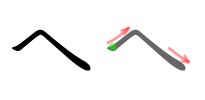Hiragana (ひらがな)
Unicode chart Hiragana
- Tabella di traslitterazione dello hiragana secondo il sistema Hepburn
Se il vostro computer ha i font per le lingue orientali potrete vedere la seguente tabella con i caratteri hiragana assieme alla loro romanizzazione in stile Hepburn. I kana in rosso sono obsoleti.
| あ a
|
い i
|
う u
|
え e
|
お o
|
ゃ(ya)
|
ゅ(yu)
|
ょ(yo)
|
|
|
| か ka
|
き ki
|
く ku
|
け ke
|
こ ko
|
きゃ kya
|
きゅ kyu
|
きょ kyo
|
| さ sa
|
し shi
|
す su
|
せ se
|
そ so
|
しゃ sha
|
しゅ shu
|
しょ sho
|
| た ta
|
ち chi
|
つ tsu
|
て te
|
と to
|
ちゃ cha
|
ちゅ chu
|
ちょ cho
|
| な na
|
に ni
|
ぬ nu
|
ね ne
|
の no
|
にゃ nya
|
にゅ nyu
|
にょ nyo
|
| は ha
|
ひ hi
|
ふ fu
|
へ he
|
ほ ho
|
ひゃ hya
|
ひゅ hyu
|
ひょ hyo
|
| ま ma
|
み mi
|
む mu
|
め me
|
も mo
|
みゃ mya
|
みゅ myu
|
みょ myo
|
| や ya
|
|
ゆ yu
|
|
よ yo
|
|
| ら ra
|
り ri
|
る ru
|
れ re
|
ろ ro
|
りゃ rya
|
りゅ ryu
|
りょ ryo
|
| わ wa
|
ゐ wi
|
|
ゑ we
|
を o/wo
|
|
|
|
ん n
|
|
|
|
| が ga
|
ぎ gi
|
ぐ gu
|
げ ge
|
ご go
|
ぎゃ gya
|
ぎゅ gyu
|
ぎょ gyo
|
| ざ za
|
じ ji
|
ず zu
|
ぜ ze
|
ぞ zo
|
じゃ ja
|
じゅ ju
|
じょ jo
|
| だ da
|
ぢ ji
|
づ zu
|
で de
|
ど do
|
|
| ば ba
|
び bi
|
ぶ bu
|
べ be
|
ぼ bo
|
びゃ bya
|
びゅ byu
|
びょ byo
|
| ぱ pa
|
ぴ pi
|
ぷ pu
|
ぺ pe
|
ぽ po
|
ぴゃ pya
|
ぴゅ pyu
|
ぴょ pyo
|
Prima lezione di ひらがな. Come leggere e scrivere le vocali giapponesi あ, い, う, え, お.
| Tratti:
|

|
| Suono:
|
a
|
| Memoria:
|
Mela - Disegna le foglie sul picciolo, poi il picciolo che scende verso la mela, infine la forma rotonda del frutto.
|
| Esempi:
|
- あお blu
- あか rosso
- あき autunno
|
| Tratti:
|

|
| Suono:
|
i
|
| Memoria:
|
Prurito - È una mano uncinata che gratta la schiena. Disegna prima la mano, poi la linea della schiena.
|
| Esempi:
|
- いぬ cane
- いもうと sorellina
- いいえ no
|
| Tratti:
|

|
| Suono:
|
u
|
| Memoria:
|
U - È la u minuscola dell'alfabeto latino. È scivolata e caduta sulla sinistra, mandando per aria la sua "gambetta".
|
| Esempi:
|
- うえ sopra
- うさぎ coniglio
- うお pesce
|
| Tratti:
|

|
| Suono:
|
e
|
| Memoria:
|
uguale Il segno = (uguale) con una "h" appiccicata! Prima disegna l' "uguale", poi la "h" sotto di esso. Non dimenticare di fare una coda lunga alla h.
|
| Esempi:
|
- えいご Inglese
- えき stazione
- えんぴつ matita
|
| Tratti:
|

|
| Suono:
|
o
|
| Memoria:
|
Oh! - Una faccia che esclama "Oh!". Prima disegna il sopracciglio sinistro, poi il profilo del viso e della bocca, infine il sopracciglio destro. Entrambi sono obliqui, vista l'espressione di sorpresa.
|
| Esempi:
|
- おおきい grande
- おちゃ tè
- おんな donna
|
Come leggere e scrivere か, き, く, け, こ. Aggiungendo due lineette chiamate 点てん (dakuten) o più semplicemente 点々(てんてん, tenten), che significa "due punti", il suono di ogni carattere muta generando altri suoni correlati. Così l'aggiunta del "tenten" modifica か, き, く, け, e こ in が, ぎ, ぐ, げ, ご.
| Tratti:
|

|

|
| Suono:
|
ka
|
ga
|
| Memoria:
|
Le linee che si intersecano rappresentano la spalla di un uomo. La linea staccata sulla destra è una tavoletta di legno. Quando la spalla colpisce la tavoletta, produce un suono simile a "Ka!"
|
| Esempi:
|
- かいもの shopping
- かばん valigia, valigetta
- かお viso
|
- がくせい studente
- がいこく paese estero
- がっこう scuola
|
| Tratti:
|

|

|
| Suono:
|
ki
|
gi
|
| Memoria:
|
Somiglia ad una chiave!
|
| Esempi:
|
- きのう ieri
- きって francobollo
- きれい pulito, bello
|
- ぎんこう banca
- ぎゅうにく manzo
- ぎん argenti
|
| Tratti:
|

|

|
| Suono:
|
ku
|
gu
|
| Memoria:
|
Il becco aperto di un uccellino che salta fuori da un orologio a cucù! (Ku!)
|
| Esempi:
|
- くるま automobile
- ください per favore
- くも nuvola
|
- ぐんじん soldato
- ぐうぜん improvvisamente
- ぐあい condizione (salute, stato)
|
| Tratti:
|

|

|
| Suono:
|
ke
|
ge
|
| Memoria:
|
Raffigura un missionario spagnolo che tiene in mano una croce e dice: "¿Que?" (Ke) (In spagnolo: "Che cosa?")
|
| Esempi:
|
- けいさつ polizia
- けっこん matrimonio
- けが danno, ferita
|
- げきじょう teatro
- げんき energia, vitalità
- げんだい moderno
|
| Tratti:
|

|

|
| Suono:
|
ko
|
go
|
| Memoria:
|
|
| Esempi:
|
- こども bambino
- こめ riso (crudo)
- ことば parola
|
- ごご pomeriggio
- ごはん meal, riso (cotto)
- ごみ spazzatura
|
Come leggere e scrivere さ、し、す、せ、そ. Aggiungendo i due てんてん tenten i caratteri さ、し、す、せ、e そ producono ざ、じ、ず、ぜ、ぞ , mutando il suono della consonante.
| Tratti:
|

|

|
| Suono:
|
sa
|
za
|
| Memoria:
|
|
| Esempi:
|
- さら piatto
- さけ alcool
- さわる toccare
|
- ざんねん pessimo, riprovevole
- ざんぎょう lavoro straordinario
- ざいがい oltreoceano
|
| Tratti:
|

|

|
| Suono:
|
Shi
|
ji
|
| Memoria:
|
La punta ricurva di uno sci (shi).
|
| Esempi:
|
- しつれい scortese
- しぬ morire
- しる sapere
|
- じぶん me stesso, sé stesso
- じしょ dizionario
- じごく inferno
|
| Tratti:
|
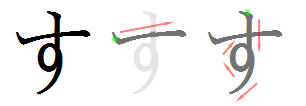
|

|
| Suono:
|
su
|
zu
|
| Memoria:
|
Una donna chiamata Su con un cappello.
È un disegno surreale.
|
| Esempi:
|
- する fare
- すみません scusami
- すごい fantastico, fico
- すし sushi
|
- ずるい intelligente, scaltro
- ずいい optional
- ずいき buon presagio
|
| Tratti:
|

|

|
| Suono:
|
se
|
ze
|
| Memoria:
|
|
| Esempi:
|
- せんたく biancheria
- せなか schiena
- せまい stretto, piccolo (ad es., una stanza)
|
- ぜひ ad ogni modo
- ぜんぶ tutto, intero
- ぜん Zen (Buddhismo)
|
| Tratti:
|
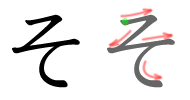
|

|
| Suono:
|
so
|
zo
|
| Memoria:
|
- Il segno di "Zorro" con una coda.
|
| Esempi:
|
- そら cielo
- そば spaghetti giapponesi
- そと fuori
|
- ぞう elefante
- ぞうき organi interni
- ぞうり sandali
|
Come leggere e scrivere た、ち、つ、て、と. Aggiungendo i due てんてん tenten, i caratteri た、ち、つ、て、e と producono だ、ぢ、づ、で、ど.
| Tratti:
|

|

|
| Suono:
|
ta
|
da
|
| Memoria:
|
Versione stilizzata delle lettere minuscole "ta". L'artista ha disegnato una t inclinata e si è dimenticato di chiudere la a.
|
| Esempi:
|
- たこ polipo
- たぬき cane procione
- たね seme
|
- だいがく università, college
- だいこん rapa giapponese
- だく abbracciare
|
| Tratti:
|
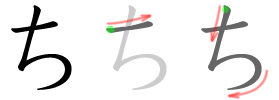
|

|
| Suono:
|
chi
|
ji
|
| Memoria:
|
- È una ci al contrario, con una croce sopra.
|
|
| Esempi:
|
- ち sangue
- ちいさい piccolo
- ちず mappa
|
- ちぢむ restringersi
- ちぢれげ capelli ricci
- はなぢ sangue dal naso
Nel giapponese moderno, nessuna parola comincia con "ぢ" e solo un piccolo numero lo utilizza.
|
| Tratti:
|

|

|
| Suono:
|
tsu
|
zu
|
| Memoria:
|
- Rappresenta l'onda di uno tsunami.
|
| Esempi:
|
- つえ bacchetta magica
- つき luna
- つくえ desk
|
- かなづち martello di ferro
- かんづめ cibo in scatola
- つづり spelling
Nel giapponese moderno, nessuna parola comincia con "づ" e solo un piccolo numero lo utilizza.
|
| Tratti:
|
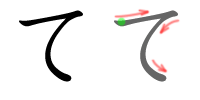
|

|
| Suono:
|
te
|
de
|
| Memoria:
|
Sembra una T.
|
| Esempi:
|
- てちょう blocco note
- てつ ferro, acciaio
- てぶくろ guanti
|
- でんき elettricità
- でんせつ leggenda
- でんわ telefono
|
| Tratti:
|
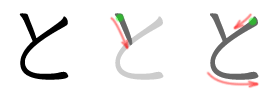
|

|
| Suono:
|
to
|
do
|
| Memoria:
|
|
| Esempi:
|
- とけい orologio
- とこや parrucchiere
- とびら porta
|
- どうぐ strumento, attrezzo
- どうぶつ animale
- どく veleno
|
Aggiungendo una piccola tsu っ prima di una sillaba, si ottiene il raddoppio della consonante. Per esempio: かった katta e しっけshikke.
Come leggere e scrivere な、に、ぬ、ね、の.
| Tratti:
|

|
| Suono:
|
na
|
| Memoria:
|
- The cross shaped figure just knocked (na) over something.
- A child cries after being told 'Nah, you can't play with us'.
- A cross, dash and an alpha sign.
|
| Esempi:
|
- なにか something
- なか inside, middle, among
- なる to become
|
| Tratti:
|

|
| Suono:
|
ni
|
| Memoria:
|
One way to remember this is to knock the 'n' over (rotate anticlock 90 degrees) then knee (ni) it horizontally to the right. Alternatively, the smilie face fell over and skinned its knee (ni).
|
| Esempi:
|
- にる to resemble, to be similar
- にく meat
- にんげん human being
|
| Tratti:
|

|
| Suono:
|
nu
|
| Memoria:
|
- Looks like an explosion, possibly from a nuke (nu).
- Looks like a bowl of soup with a noodle (nu) spilling out.
- A way to remember the difference between ぬ (nu) and ね (ne) is that ぬ is the one with the u shape (it's actually more of a v) near the center of the character.
|
| Esempi:
|
- ぬるい lukewarm, tepid
- ぬぐ to take off (clothing)
- ぬれる to get wet
|
| Tratti:
|
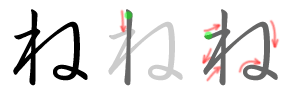
|
| Suono:
|
ne
|
| Memoria:
|
- It looks like the letters 't' and 'e' with the e upside down. Add an n and you get "ten". Reverse that and you get "net" (ne).
- One way to remember this is to rotate the 'e' of 'ne' until it's upside down then move it under arch on the 'n', merge the right sides of both letters together and hoist a mast (+) to signal your success.
|
| Esempi:
|
- ねん year
- ねぎ spring (green) onion
- ねだん price, cost
|
| Tratti:
|
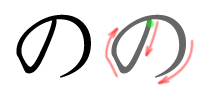
|
| Suono:
|
no
|
| Memoria:
|
- の is similar to the forbidden traffic symbol. Which is the main word for forbidden: NO.
- の looks like both an n and an o morphed together into one character. It is n-shaped, but has the roundedness of an o.
|
| Esempi:
|
- のう brain, memory
- のる to ride, to board
- のうみん farmer
|
In this lesson you are going to learn how to read and write は、ひ、ふ、へ、ほ. Adding two small lines called Template:RubyTemplate:Ruby dakuten, but commonly known simply as Template:Ruby tenten, meaning "two marks", causes clear Suonos to change to their voiced Suono. Thus, adding the Template:Ruby tenten marks to は、ひ、ふ、へ、and ほ will produce ば、び、ぶ、べ、ぼ. Adding a small circle called a Template:RubyTemplate:RubyTemplate:Ruby handakuten, but commonly known simply as a Template:Ruby maru, "circle" causes clear Suonos to change to their plosive Suono. Thus, adding a Template:Ruby maru to は、ひ、ふ、へ、and ほ will produce ぱ、ぴ、ぷ、ぺ、ぽ.
| Tratti:
|

|

|

|
| Suono:
|
ha
|
ba
|
pa
|
| Memoria:
|
- It's a missionary, holding up a cross and laughing, "Ha!"
- It looks like Ha, but the left arm of the H is broken, and the a is squeazed under the right arm.
|
| Esempi:
|
- はこ box
- はね wing
- はる springtime
|
- ばか fool
- ばしゃ carriage
- ばら rose
|
- かっぱ water imp (in Japanese folk tales)
- ぱちんこ slingshot
- らっぱ trumpet
|
| Note:
|
は is pronounced wa when used as a particle.
|
| Tratti:
|
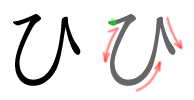
|

|

|
| Suono:
|
hi (aiuto)
|
bi
|
pi
|
| Memoria:
|
- Somebody's mouth as they say "hi!" really loudly. Just remeber that the 'i' is pronounced like 'ee'.
|
- Someone smiling wide at a good joke, 'Heeheehee'. He thought it funny to be (bi) hit by (bi) a piece (pi) of pie.
|
| Esempi:
|
- ひと human
- ひめ princess
- ひる daytime
|
- びじゅつ fine arts
- びじん beautiful woman
- びん bottle
|
- えんぴつ pencil
- しんぴ mystery
- ねんぴ mileage
|
| Tratti:
|

|

|

|
| Suono:
|
fu (aiuto)
|
bu
|
pu
|
| Memoria:
|
The squiggly line looks like a snake - think of the game Snake. The other lines are the food (fu) that the snake is going after.
The squiggly line leads to the top of Mt. Fuji.
|
| Esempi:
|
- ふうふ married couple
- ふえ flute, whistle
- ふく clothes
|
- ぶき weapon
- ぶた pig
- ぶん sentence
|
- しんぷ priest
- せっぷく hara-kiri
- せんぷうき electric fan
|
| Tratti:
|

|

|

|
| Suono:
|
ho
|
bo
|
po
|
| Memoria:
|
- Think mini-golf. The line on the left is the putter, the lines on the right are the flag, and the circle is the hole (ho).
|
- It's a whole person standing next to a lamp post.
|
| Esempi:
|
- ほうき broom
- ほね bone
- ほん book
|
- ぼう stick
- ぼく - A first personal pronoun usually used by men
- ぼろ defect
|
- しっぽ tail
- ぶんぽう grammar
- こどもっぽい childish
|
In this lesson you are going to learn how to read and write ま、み、む、め、も.
| Tratti:
|

|
| Suono:
|
ma
|
| Memoria:
|
My ma (mother) has power lines running through her front yard (because ま looks like power lines).
Looks like the mast (ma) of a ship.
|
| Esempi:
|
- まくら pillow
- まく to sow (seeds)
- まち town
|
| Tratti:
|
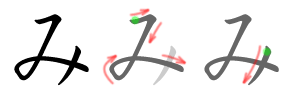
|
| Suono:
|
mi
|
| Memoria:
|
I am the little line on the right. The big, curling line on the left is elaborately pointing at me (mi).
Silly me (mi), I started to draw a 7, then changed my mind and drew a 2, then tried to cross out the tail because it was too long.
|
| Esempi:
|
|
| Tratti:
|

|
| Suono:
|
mu
|
| Memoria:
|
It looks like the face of a sad cow (moo!). The bottom trough is his nose and the short lines are the eyes.
|
| Esempi:
|
- むし insect
- むすめ daughter
- むい unintentional
|
| Tratti:
|

|
| Suono:
|
me
|
| Memoria:
|
- The two middle lines met (me) in the center of the ring.
- It is a knot tied around your finger to jog your memory.
- You can tell it's different from nu (ぬ) because it's less of a mess.
|
| Esempi:
|
- め eye
- めん cotton
- めす female
|
| Tratti:
|

|
| Suono:
|
mo
|
| Memoria:
|
This is a very greedy symbol. It already has two lines, and it's waving it's arm, gesturing for "more" (mo).
It is a fish hook with two pieces of bait to catch more fish.
|
| Esempi:
|
- もも peach
- もん gate
- もり forest
|
In this lesson you are going to learn how to read and write や、ゆ、よ.
| Tratti:
|

|
| Suono:
|
ya
|
| Memoria:
|
Someone shouting 'Ya!' as they punch through a board.
|
| Esempi:
|
- やま mountain
- やえいち campsite
- やくそく arrangement, promise
- やせい wild, rough
|
| Tratti:
|
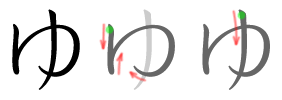
|
| Suono:
|
yu
|
| Memoria:
|
- Picture a monkey sitting on a curled tree trunk. The monkey says, "Hey you!" (yu).
- It could also be you with your arm around another's arm.
|
| Esempi:
|
- ゆらぐ to tremble
- ゆめ dream
- ゆげ steam
|
| Tratti:
|
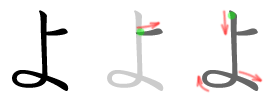
|
| Suono:
|
yo
|
| Memoria:
|
- Yoyo - It's a hand playing a yoyo. First you draw the hand, and then the yoyo itself.
- Alternatively, imagine a Y conjoined with an O.
|
| Esempi:
|
- よこう rehearsal
- ようかい ghost, demon
|
Certain Suonos ending with -い(i) ( き(ki), し(shi), ち(chi), に(ni), ひ(hi), み(mi), り(re) and their variations) can be followed by small versions (ゃ, ゅ, and ょ) of the hiragana や(ya), ゆ(yu), and よ(yo). In this case, the two hiragana are not pronounced individually, but rather as one Suono.
In most cases, the compound Suono is the consonant of the base syllable followed by the modifier (fjord may be an Esempi of a similar compound Suono in English):
- きゃ (kya)
- きゅ (kyu)
- きょ (kyo)
In other cases the y Suono disapears entirely:
- しゃ (sha)
- しゅ (shu)
- しょ (sho)
Look at the Kana Chart for the others.
In this lesson you are going to learn how to read and write ら、り、る、れ、ろ.
| Tratti:
|
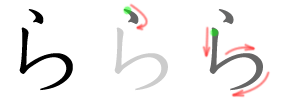
|
| Suono:
|
ra (aiuto)
|
| Memoria:
|
The face of someone enjoying the smell of their ramen. Draw his eyebrow first, then his nose and mouth.
|
| Esempi:
|
- らくだ camel
- らっぱ trumpet
- らば mule
|
| Tratti:
|
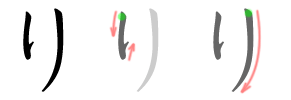
|
| Suono:
|
ri (aiuto)
|
| Memoria:
|
It's the nose and cheek of Richard.
|
| Esempi:
|
- りんご apple
- りす squirrel
- りゅう dragon
|
| Notes:
|
The handwritten form varies slightly from the printed form り
|
| Tratti:
|
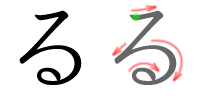
|
| Suono:
|
ru (aiuto)
|
| Memoria:
|
- The arm and closed fist of a student who has to hold buckets of water out in the hall because he broke the rules.
- A boat hit a message in a rum bottle (the upper part being the boat, the lower the corked bottle).
|
| Esempi:
|
- るす absency (from home)
- るり Lapis Lazuli
- るつぼ melting pot
|
| Tratti:
|
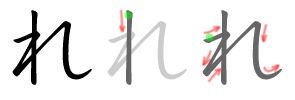
|
| Suono:
|
re (aiuto)
|
| Memoria:
|
- The t on the left is the end of a pier, and its builder recommends replacing it.
- You can distinguish it from ね and わ because it has the tip of the second wave, visible on the right
|
| Esempi:
|
- れきし history
- れいそく your son
- れい spirit (after death)
|
| Tratti:
|
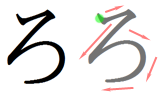
|
| Suono:
|
ro (aiuto)
|
| Memoria:
|
- It's the front tip of a row boat riding a wave.
- It's the tail and hindquarter of a roaring lion.
- You can distinguish it from る because 'ro' doesn't have the circle at the bottom; the 'o' is in 'ro', not in its character.
|
| Esempi:
|
- ろく six
- ろうそく candle
- ろんぶん essay, thesis, dissertation
|
In this lesson you are going to learn how to read and write わ、を、ん.
| Tratti:
|
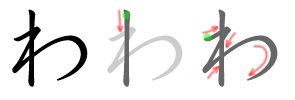
|
| Suono:
|
wa
|
| Memoria:
|
The two perpendicular lines are the end of a pier being hit by a wave of water.
|
| Esempi:
|
- わし eagle
- わに alligator
- わるい bad
|
| Tratti:
|

|
| Suono:
|
Similar to o. When spoken, the mouth is shaped as if saying 'w', and a trace of the 'w' appears in the Suono so in English it is often written 'wo'. The 'w' is particularly noticeable when the preceding word ends in 'n', for Esempi in パンを食べる meaning to eat bread.
|
| Memoria:
|
A man stepping into a bending river. "Whoa, it's cold."
|
| Esempi:
|
- を - a particle introducing an object
- すさのをのみこと - Susanoo (or Susanowo), an ancient god of the storms and seas
In modern Japanese, no words other than the particle itself contain the "を" syllable.
|
| Tratti:
|
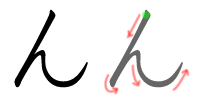
|
| Suono:
|
Can Suono like an n, ng, or m Suono, depending on what consonant follows it (for Esempi, if a "p" follows, this Suono will be an "m"). Because there is little differentiation between these Suonos in Japanese, using n for all Esempis will still be clearly understood.
|
| Memoria:
|
N - It looks like a badly drawn n from the Roman alphabet. The stem is too long and the tail extends too far.
|
| Esempi:
|
- おんな female
- さんご coral
- さんそ oxygen
No native Japanese word starts with "ん", as is it only used to end syllables.
|
In this lesson you are going to learn how to read and write ゐ and ゑ. These characters are not in modern Japanese but because they were legitimate characters before, one sees them in old Japanese text.
| Tratti:
|

|
| Suono:
|
Exactly the same as I, but in ancient times there was a clear difference. Scholars guess that the Suono was something like Wi.
|
| Memoria:
|
Same as I.
|
| Esempi:
|
- ゐ well (normally written in hiragana as い, but sometimes written in the former way to differentiate it)
|
| Tratti:
|
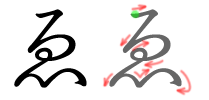
|
| Suono:
|
Exactly the same as E, but in ancient times there was a clear difference. Scholars guess that the Suono was something like We.
|
| Memoria:
|
Same as E.
|
| Esempi:
|
- ゑびす - Ebisu, one of the seven lucky gods, and also the name of a Japanese beer.
|
>

















































